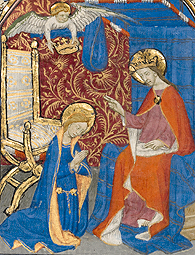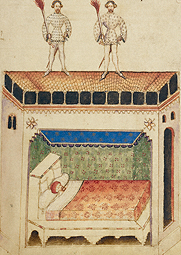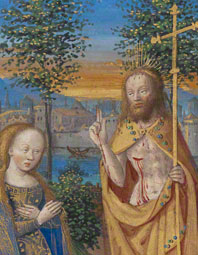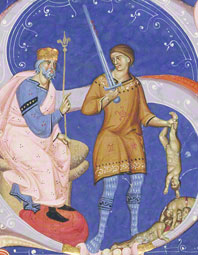|
Prayer, both personal and communal, was an integral aspect of life in Europe during the Middle Ages. The readings and rites contained in Christian devotional books were often accompanied by lavish decorations that were key in fostering and expressing the religious beliefs of the faithful. Executed in precious pigments and gold, illuminated manuscripts not only played a central role in the spiritual lives of medieval audiences but also served as material testaments to the piety of the books' owners.
In the illumination Noli me tangere, Mary Magdalene kneels in awe before the risen Christ, having expected to anoint his dead body after the Crucifixion. He says to her, "touch me not" (noli me tangere in Latin). This image decorates a type of small manuscript intended for private devotion; it is called a book of hours because it includes a cycle of prayers that were said at set hours of the day.
|
 |
|
Christian ceremonies gradually transformed into a series of complicated rites and performances over the course of the Middle Ages. The books produced for the liturgy (public worship services) often received rich decorative treatment, both to emphasize the religious importance of the readings and to symbolize the wealth and power of the church. Bibles and missals were placed on the altar during services, while music manuscripts were positioned on a lectern for multiple participants.
In a dramatic illustration that accompanies the chants for the feast of the Holy Innocents, the biblical king Herod sits at left, giving an order for the massacre of all male children under the age of two in an effort to kill the Christ child. At right a soldier holds an infant upside down by the leg, preparing to use his sword. This image appears in an antiphonal, a large manuscript that contains choral music sung during church services.
|
 |
 |

 |
 |
The Coronation of the Virgin (detail), from a book of hours, Master of the Harvard Hannibal, Paris, about 1420–30
On view during first installation: August 28–November 11, 2012
|
 |
Throughout the Middle Ages, small, handheld books with beautiful script and decorations encouraged private devotion, as pious individuals outside the church sought to imitate the daily prayer cycle known as the Divine Office recited by clerics, monks, and nuns. Breviaries (containing the texts of the Divine Office), psalters (with the biblical Psalms), and books of hours (an abbreviated form of the breviary for laypeople) were all designed for those who could afford such luxuries.
The Hours of the Virgin is a series of prayers at the core of the book of hours, and the image The Coronation of the Virgin introduces compline, the last prayer said before bed. Each of the eight hours was typically illuminated with a scene from Mary's life. Her crowning by Christ was often considered the most appropriate ending image, as she was to sit enthroned at Christ's side for eternity.
|
 |

 |
 |
Saints Aimo and Vermondo Threatening to Burn the House of the Monasterys Enemy (detail), in Legend of the Venerable Men Aimo and Vermondo, attributed to Anovelo da Imbonate, Milan, about 1400
On view during first installation: August 28–November 11, 2012
|
 |
 |
A variety of texts were written and illuminated during the Middle Ages to encourage piety and contemplation—and to meet a rise in literacy. The Bible and writings of early theologians, originally in Latin but also translated into local languages for greater accessibility, were primary texts. The lives of Christ and Mary, who were considered models of proper behavior, inspired imaginative accounts of events not recorded in the Bible. Illustrated stories of saints, full of entertaining narratives, also found popularity.
This scene represents a story associated with the brother saints Aimo and Vermondo after their deaths; they hold flaming torches as they stand on the house of a man who attempted to steal the land of a monastery they had established. Such posthumous miracles were a popular aspect of saints' legends, as people believed that their prayers could invoke the help of their favorite holy figures from beyond the grave.
|
 |




